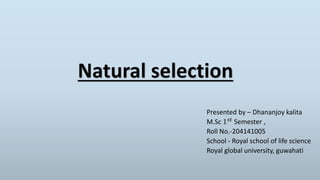
Natural selection
- 1. Presented by – Dhananjoy kalita M.Sc 1𝑠𝑡 Semester , Roll No.-204141005 School - Royal school of life science Royal global university, guwahati
- 2. •CONTENTS : Introduction Darwin’s points on natural selection — Overpopulation — Competition ― Variation — Survival of the Fittest — Inheritance of Useful Variation — New Species Examples of natural selection Types of natural selection — Stabilizing Selection — Directional Selection — Disruptive Selection
- 3. • INTRODUCTION : • Natural selection is Darwin’s most famous theory. • The machanism for adaptation and evolution is called “natural selection” • This theory states that - “ Those organisms best adapted to their environment have a better chance of surviving and reproducing.” • Darwinism : Darwin's Theory of Natural Selection. • The theory of the evolution of species by natural selection advanced by Charles Darwin announced on July 1, 1858. • “On the origin of species by Means of Natural Selection “, November,1859.
- 4. DARWIN’S 6 POINTS OF NATURAL SELECTION 1.Overpopulation 2.Competition 3.Variation 4.Survival of the Fittest 5.Inheritance of Useful Variation 6.New Species Source - https://cdn.nybooks.com/wp-content/uploads/2020/03/darwing_charles-042320.jpg
- 5. 1. OVERPOPULATION Organisms tend to produce many offspring – more than the environment can support Organisms will reproduce until something stops them (usually food) e.g. - Paramecium divide 3 times in 48 hours with this rate, a single paramecium will produce in 5 year a mass of paramecium equal to ten thousand times the size of earth. Plant produce thousands of seed each year. Cod fish may produce over a million egg in a year. If all the egg developed into fishes, the whole Atlantic Ocean will be full of cods in Five years. Source: http://www.mosaictraining.ca/fishing/images/stories/whatson%2013.jpg
- 6. 2. COMPETITION •Because of overpopulation, individuals compete with one another over limited resources → food, water, shelter, mates •The Struggle for existence is 3 fold for every individual :- Intraspecific struggle - Within species Interspecific struggle - Different species Environmental struggle - Change in environmental factor (heat, cold, drought, flood etc) Source - https://biologydictionary.net/wp-content/uploads/2018/10/Intraspecific-competition.jpg Source - https://static.todamateria.com.br/upload/54/35/5435978db2860-predatismo.jpg Source - https://theaimn.com/wp-content/uploads/2019/01/roo-at-menindee.jpg
- 7. 3. VARIATION • Understanding how individuals of the same species vary was key to Darwin developing his theory. • Because the environment changes, the more variation within a species, the more likely it will survive. • Each individual has a unique combination of inherited traits. • An inherited traits that increase an organism's change of survival is called “Adaptation”. Source - https://i.pinimg.com/originals/4a/55/c7/4a55c76a43b30ac8c8d5a90f52e399c0.gif
- 8. 4. SURVIVAL OF THE FITTEST (NATURAL SELECTION) • The individuals with the best traits / adaptations will survive and have the opportunity to pass on it’s traits to offspring. • Natural selection acts on the phenotype (physical appearance), not the genotype (genetic makeup). Source - https://img.favpng.com/21/12/15/natural-selection-selective- breeding-evolution-survival-of-the-fittest-adaptation-png-favpng- g4aA4ww82f3J9VkiYDB4mSnws.jpg Source - https://images.app.goo.gl/U6V4vg6q7KfEnzGS8
- 9. 5. INHERITANCE OF THE USEFUL VARIATION • The individual, selected by nature, pass on their useful variation to the next generation. • Thus, offspring of fit individual also be fit. Source - https://images.app.goo.gl/486ZVXNkgxMUuFG57
- 10. 6. NEW SPECIES • New species results by inheritance of trait(s), on genes, that give them another advantage over others. • In each generation, new favorable variations appear and supplement the favorable. • After a number of generation the variations become so many which generate a new species. • New species evolve! Source - https://kullabs.com/uploads/253.jpg
- 11. EXAMPLES OF NATURAL SELECTION 1. Darwin’s finches 2. Peppered moth 3. Pesticide resistant mosquitoes Source - https://encrypted- tbn0.gstatic.com/images?q=tbn:ANd9GcSFzCHLIx84oM- qKYyL0rBCw9jApjGWz0uqIw&usqp=CAU Source - https://i.redd.it/b855rcxdtknz.jpg Source - https://upload.wikimedia.org/wikipedia/commons/thumb/6/6 e/Pest_resistance_labelled_light.svg/1200px- Pest_resistance_labelled_light.svg.png
- 12. TYPES OF NATURAL SELECTON 1. STABILIZING SELECTION – This type of natural selection occurs when there are selective pressures working against two extremes of a trait and therefore the intermediate or “middle” trait is selected for. If we look at a distribution of traits in the population, it is noticeable that a standard distribution is followed: Example: For a plant, the plants that are very tall are exposed to more wind and are at risk of being blown over. The plants that are very short fail to get enough sunlight to prosper. Therefore, the plants that are a middle height between the two get both enough sunlight and protection from the wind. Source - https://sites.google.com/site/naturalselection12345/_/rsrc/146888619888 3/process-1/url.gif?height=211&width=320
- 13. 2. DIRECTIONAL SELECTION This type of natural selection occurs when selective pressures are working in favour of one extreme of a trait. Therefore when looking at a distribution of traits in a population, a graph tends to lean more to one side: Example: Giraffes with e longest necks are able to reach more leaves to each. Selective pressures will work in the advantage of the longer neck giraffes and therefore the distribution of the trait within the population will shift towards the longer neck trait. Source - https://image.slidesharecdn.com/typesofselection-100612202246- phpapp02/95/types-of-selection-5-728.jpg?cb=1276374223
- 14. 3. DISRUPTIVE SELECTION This type of natural selection occurs when selective pressures are working in favour of the two extremes and against the intermediate trait. This type of selection is not as common. When looking at a trait distribution, there are two higher peaks on both ends with a minimum in the middle as such: Example: An area that has black, white and grey bunnies contains both black and white rocks. Both the traits for white and black will be favored by natural selection since they both prove useful for camouflage. The intermediate trait of grey does not prove as useful and therefore selective pressures act against the trait. Source - https://sites.google.com/site/naturalselection12345/_/rsrc/1468886200 067/process-1/url-2.gif
- 15. Source - https://o.quizlet.com/xZHfGcc44lgk44wnnrkfgw_b.jpg Source - https://upload.wikimedia.org/wikipedia/commons/thumb/8/82/Directional%2C_Disruptive_a nd_Stabilizing_Selections.svg/1200px- Directional%2C_Disruptive_and_Stabilizing_Selections.svg.png
- 16. Thank you
